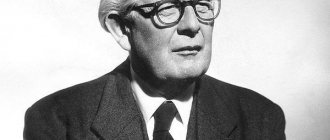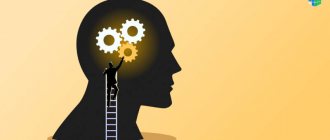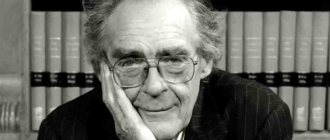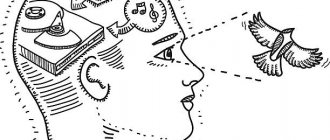How does our ability to think logically and clearly develop? What happens in the child's brain as the child acquires the skills of understanding and awareness of the phenomena of the surrounding reality? In other words, what is hidden behind the process of cognitive development, and what is it even?
Let's take a closer look at this concept and consider the features of the development of thought processes in human beings. In this article we will introduce you to the main phenomena and milestones of cognitive development, as well as to one of the leading theorists in this field - Jean Piaget, and the stages he identifies in this important process.
In this article we will focus on the first two such stages, and in the next article we will continue the topic. There we will also indicate some practical ways and recommendations for parents who would like to help their child with his cognitive development.
So, first let's define what is meant by this term and what factors are important here.
What is cognitive development
Cognitive development is the development of thinking in children, during which they comprehend, learn and comprehend things and phenomena. This involves developing the knowledge, abilities, problem-solving skills and dispositions that help children make sense of and understand the world around them. According to Wikipedia, cognitive development covers the development of all mental processes such as perception, memory, concept formation, problem solving, imagination and logic.
Cognitive development can also be called mental development because it affects thinking and mental processes. The development of the brain itself (various brain structures) is an integral part of cognitive development.
As you know, in the first five years of life, children develop rapidly and actively. Their formation unfolds in four important planes:
- Motor (physical) development.
- Language and communication.
- Social-emotional development.
- Cognitive development.
A person’s mental development depends on a number of factors, and their influence is not always clear and uniform. The main ones are:
- genetic factors;
- the course of pregnancy in the mother;
- environmental factors (eg, nutrition, sufficient mental stimulation);
- number of children in the family;
- socio-economic status of the family;
- influence of school and teaching methods;
- personal characteristics of the child and parents, such as temperament, personal style of learning and mastering material, etc.;
- personal qualities of parents, for example, a high level of intelligence or creativity, nonconformism, etc.;
- and other factors.
How mentally developed a person will be depends on various prerequisites, but the process of cognitive development itself occurs in all people in a fairly similar way, passing through the main stages. The first to identify important phases in the development of thinking in children was the Swiss researcher Jean Piaget (1896-1980). His theory and discoveries had a huge impact on the subsequent improvement of psychological theory and understanding of child development, and were in some way revolutionary.
Jean Piaget's theory is widely known and is currently being studied, although it has been supplemented and corrected by more modern research and discoveries. It provides an opportunity to lift the curtain on how a child acquires thinking skills and develops his or her thinking, logic, perception and problem-solving skills. It is worth considering in more detail.
Critical assessment of the main provisions of the theory of J. Piaget
Criticism of Piaget's theory is represented very widely in both modern foreign and domestic psychological science.
If Piaget believed that a baby becomes representative only by the age of one and a half to two years, thanks to the gradual combination of disparate sensations in actions with objects, then all world literature, starting from the 70s of the last century, provided evidence of the presence of representations in infants of several months. Moreover, the formation of representations did not occur due to the gradual integration of disparate sensations, as in Piaget, but, on the contrary, through the gradual differentiation of a diffuse whole representation to a more detailed and differentiated one.
Numerous criticisms of Piaget indicate, in my opinion, the depth and enormous significance for psychology of Piaget’s works. The theory of the development of thinking he proposed has enduring scientific values. Here are some of them. Firstly, the concept of J. Piaget is an example of a truly evolutionary approach to the problems of the formation of thinking. The main idea of describing the stages of development of thinking is the continuity, continuity of the development of complex rational thinking through a gradual transition from irrational at birth through the formation of the originality of children's pre-operative, intuitive conclusions to the logic of adult judgments. At the same time, let us recall that Piaget did not insist on chronological age criteria, but emphasized continuity and consistency in the development of thinking. Many models of consciousness, mental phenomena of consciousness are described as if they arise suddenly (as when turning on a light). Note that this is typical not only for the field of cognitive psychology, but also for the psychology of personality, individuality, and subjectivity.
The second feature of Piaget's theory, which remains, of course, modern, is the depth of psychological interpretation of facts and their causes. Piaget's works are distinguished by unsurpassed logic and inventive experimentation. Moreover, it is in his works that an interdisciplinary approach is implemented (psychology, biology, logic, mathematics). The existing myth about Piaget's three subjects was invented for self-justification. Thus, in the book devoted to the mental operations of classification and seriation, written jointly with B. Inelder, 2159 subjects are indicated, the data of which are summarized only on this problem. Above all, Piaget valued the depth of psychological interpretation, a comprehensive analysis of the psychology of decision, inference, and judgment. In 1918, he wrote that psychologists had achieved remarkable trivialities along the way by overgeneralizing their methods, especially when a whole army of scientists was engaged in translating their results into the language of mathematical methods. Using complex mathematics, graphs and calculations, these psychologists demonstrated the simplest and most obvious results... but nothing more.
Finally, Piaget believed in the future of psychology, which should be the center not only of the human sciences, but also the center of all sciences. He saw the future of psychology in its own development and the fertilization of its interdisciplinary connections, which in turn would open new horizons to other sciences. At the congress in Moscow, he said: “The future of psychology is, first of all, its own development... Its future is also determined by a set of interdisciplinary connections, through which it will enrich itself with the achievements of other sciences and, in turn, contribute to their enrichment.”
Jean Piaget's theory of cognitive development
Piaget's merit lies in the fact that he approached the issue of the development of thinking in children as a central process of their development, in which the child acts as an active participant, an inquisitive and experimental researcher-scientist, conducting experiments and interacting with the world around him. During this exploration and interaction with the surrounding reality, the child develops his cognitive abilities and acquires valuable skills in understanding the world and phenomena.
Previously, this topic was dominated by a discussion about what factors predetermine the development and characteristics of a person - “natural” factors: innate properties and biological maturation, or “acquired”: learned and acquired properties, environmental influence (nature vs nurture). This dichotomy is false, because both factors play their role.
Jean Piaget's approach starts from a different premise - at the center is the question of what discoveries a child makes in his development and what skills he acquires in the process. The stages of development that Piaget identified reflect the main milestones of this path. There are only four of them.
But before we move on to a detailed examination of each of them, it is necessary to clarify several important concepts introduced by the Swiss psychologist. Piaget believed that on the basis of his experiments and interactions, the child builds certain theories or ideas, which Piaget called schemes (German: schema, schemata). These are concepts or mental constructs (models) that a child uses to categorize and interpret information. For example, if a child has had dogs in his experience, he has a schema for them, and when he meets new dogs, he will recognize them as just such animals.
The created schemes can be modified and supplemented in two main ways:
- Assimilation is the process of assimilation of information similar or comparable to existing information. In this case, the child adds new information to an already existing scheme. For example, a child has had experience with large, furry dogs, but seeing a Chihuahua for the first time, he correlates such a dog with the usual dogs in his scheme.
- Accommodation is the process of changing existing patterns based on new information. In this case, the new data does not fit into the old schemes - there is no suitable model for them yet, and the person modifies his understanding. For example, a child may call a fox a dog because he has a schema only for the latter. After his parents correct him and explain that it is a fox and not a dog, he adjusts his schemes.
These processes are inherent not only to children exploring the world, but also to adults. These two processes take place throughout all four stages of development identified by Piaget.
Piaget's contribution to psychological science
What can be considered the main result of Piaget’s scientific activity? He created the Geneva School of Genetic Psychology, which studies the mental development of the child. The term "genetic", as used in the expression "genetic psychology", was introduced into psychology in the second half of the 19th century, that is, before biologists began to use it in the narrower sense of the word. The term “genetic psychology” refers to individual development, to ontogenesis. As Piaget notes, the expression “genetic psychology” cannot be used as a synonym for child psychology, the psychology of child development, since general psychology is also called genetic if it considers mental functions in the process of formation.
What does genetic psychology, created by Piaget, study? The object of this science is the study of the origin of intelligence. She explores how fundamental concepts are formed in a child: object, space, time, causality. She studies the child’s ideas about natural phenomena: why the sun and moon don’t fall, why clouds move, why rivers flow, why the wind blows, where the shadow comes from, etc. Piaget is interested in the features of children's logic and, most importantly, the mechanisms of the child's cognitive activity, which are hidden behind the external picture of his behavior.
To identify these mechanisms, hidden but determining everything, Piaget developed a new method of psychological research - the method of clinical conversation, when not symptoms (external signs of a phenomenon) are studied, but the processes leading to their occurrence. This method is extremely difficult. It gives the necessary results only in the hands of an experienced psychologist. According to E. Claparede, Piaget's method is mental auscultation and percussion, this is an art - the art of asking.
Piaget critically analyzed the methods that were used before him and showed their inadequacy for elucidating the mechanisms of mental activity. And now, when the test method is increasingly attracting the attention of psychologists, it is worth recalling Piaget’s positions on this issue. Half a century ago, he proved that tests can only serve selection purposes, but do not provide an idea of the inner essence of the phenomenon. What problems does the genetic psychology created by Piaget solve? This science studies how the transition occurs from one form of mental activity to another, from a simple structure of mental activity to a more complex one, and what are the reasons for these structural transformations. She studies the similarities and differences between the mental life of a child and an adult.
The genetic psychology created by Piaget, as recognized by foreign researchers, is developing in three directions:
1. the problems that constitute its subject are determined;
2. research technique is developed;
3. accumulation, organization and interpretation of facts occur.
Piaget's genetic psychology occupies a special place in the system of sciences between biology and philosophy. The desire to connect biology and problems of cognition explains Piaget's dual orientation as a psychologist. Therefore, as noted by his student and closest collaborator B. Inelder, in order to understand Piaget’s theory, one must know the biological premises from which it comes and the epistemological conclusions to which it leads.
Piaget created genetic psychology so that a genetic epistemology could be built on its basis. According to Piaget's definition, genetic epistemology attempts to explain cognition, and in particular scientific knowledge, on the basis of its history, sociogenesis and the psychological origins of those concepts and operations on which scientific knowledge is based. Piaget was deeply convinced that psychological data must be used to study the nature of cognition. To solve fundamental epistemological problems (chief among them the means by which the human mind moves from a state of insufficient knowledge to a higher level of knowledge), we cannot reconstruct the genesis of human thinking in prehistoric man. We know nothing about the psychology of Neanderthal man or the psychology of Cro-Magnon man. But we can turn to ontogenesis, because it is in children that it is best to study the development of logical, mathematical and physical cognition.
So, based on the prospect of creating genetic epistemology, the science of the origin and development of scientific knowledge, Piaget transferred traditional questions of the theory of knowledge to the field of child psychology and began to solve them experimentally. He was interested in whether the subject distinguishes the external world from the internal, subjective world and what are the boundaries of such a distinction. Piaget wanted to find out whether the external world acts directly on the subject's mind or whether his ideas are products of his own mental activity. And if the subject is active in the process of cognition, then what is the interaction between his thought and the phenomena of the external world, what are the laws to which this interaction is subject, what is the origin and development of basic scientific concepts?
Stages of cognitive development according to Jean Piaget
As we have already noted, the Swiss researcher identified four stages of development in children, from birth to adulthood:
- Sensorimotor stage (0-2 years).
- Pre-operational stage (2-6 years).
- Stage of concrete operations (7-11 years).
- Formal Operations Stage (12 years and older).
According to Piaget, the development of thinking in people is formed and reaches a maximum by adulthood, therefore, in his theory, the process of cognitive development ends at this phase. However, recently the limitations and fallacy of this view have been proven due to the fact that the human brain has the property of neuroplasticity, and we are able to learn new things, master new skills and strategies, and expand our horizons and abilities. As the saying goes, “Live and learn,” a person usually continues to acquire new knowledge and practical skills throughout his life.
So, what characterizes each of the stages of development of our thinking?
5) About the transformation of subject and object.
The object exists independently of the subject. To know an object, the subject must act with these objects and transform them. Initially, the boundary between the object and the subject is not established (not stable). The object is the material for the development of the subject. The source of knowledge lies in the interactions between the subject and objects. As a child develops, he interacts with objects, transforming and transforming them. At the same time, the leading role in cognition is played not by the object itself, but by the dominant mental structures of the subject.
Sensorimotor stage (birth to 2 years)
The first stage is called sensorimotor because at this stage children have a special connection between motor (motor) activity and thinking (sensory perception). At this stage, babies master various motor skills - grabbing, holding on to objects, throwing, crushing, hitting, etc. In the process of such actions, they comprehend how objects behave and what will happen if they are treated this way.
The child begins to realize himself as a bearer of action, as well as the fact that he is a separate subject. He notices the result of his actions and learns to act voluntarily, with the intention of obtaining a certain effect. For example, an infant shakes a rattle to make a sound.
The most important discovery at this stage is the concept of object permanence - the child learns that an object continues to exist, even if it becomes inaccessible to the senses, i.e. invisible or out of sight. Thus, children aged 5 to 8 months discover that even if a toy is hidden, for example, under a blanket or behind something, then, although it is not visible, it is there and can be taken. However, a child about a year old will still look for the toy where he last found it, and not where he saw it hidden.
To better understand what this looks like, watch this short video in English showing children's varying abilities to understand the principle of object permanence.
Another significant phenomenon observed around the same time in children at the sensorimotor stage of development is fear of strangers. It is caused by the fact that the child is not able to assimilate strangers and strangers into his existing schemes.
The first stage of development, spanning ages from birth to about 2 years, is followed by the preoperational stage.
1) About the relationship between the whole and the part.
There are no isolated elements. The relationship between the whole and the parts varies depending on the structure in which they are included. The relationship between the whole and the part tends to balance.
2) About self-regulation and balance
.
An essential feature of all living organisms is that they are self-regulating systems that are able to maintain or restore their structure. Any living subject strives for balance with the external environment. The external environment is constantly changing => the creature has to self-regulate. Man and his intellectual development are not an exception.
Pre-operational stage (from 2 to 6 years)
The second stage generally corresponds to preschool age (it must be taken into account that the age indicated in this theory is approximate). It was called pre-operative, because. At this stage, children do not understand operations - logical manipulations, and do not know how to think logically. Operations refer to procedures such as division, union and other transformations that require logical thinking. In other words, a child at this stage, especially at its beginning, is not able to use logical categories and operations: classify, compare, evaluate, measure, etc.
However, at this stage, a very important feature is observed - children master speech and begin to actively use symbolic thinking. Those. they use words and symbols to represent objects, groups of objects, images and ideas, and actively use imagination and symbolic play. Thus, cubes can become kingdom subjects or buildings, and a child’s hands can become airplane wings. Such play and the ability to “pretend” is actually an important cognitive achievement—a degree of abstraction not available to great apes and other animals.
Jean Piaget believed that children at this stage are unable to maintain attention on more than one aspect of a situation or characteristic, and in addition, children's logic is based on personal experience rather than generally accepted rules and laws. Thus, at the age of 3-4 years, children are not able to understand the concept of conservation of matter. The principle of conservation is the understanding that the amount of a substance will remain the same even if its shape changes. For example, if you pour water from a short and wide glass into a tall and narrow one, there will be the same amount of water in it. And if you roll out a ball of plasticine into an oblong sausage, the amount of plasticine will not change. Such operations become available to children only at the next stage of cognitive development.
To see what the logic of children at an early stage of the pre-operational stage of development (who have not yet mastered the principle of conservation of mass and quantity) looks like in life, watch this video. (https://www.youtube.com/watch?v=ZDNi4z5tdqU)
Another distinctive feature of this stage is children's egocentrism. In this context, this means that a child up to the age of approximately 3 years perceives the world as an extension of himself, exactly as he sees it, without realizing and often with difficulty accepting points of view that differ from his own. At this stage, it is natural for children to believe that everyone sees and perceives the world exactly the same as they do, and has the same feelings, thoughts, preferences and desires.
Between about 3 and 5 years of age, children begin to realize that other people have their own points of view, feelings and thoughts, and they perceive the world differently, in their own way. This phenomenon is called the model of the human psyche (or theory of mind, in English).
The pre-operational stage is replaced by the stage of concrete operations, at which children demonstrate a greater ability for logical thinking. We will consider this, as well as the fourth stage - formal operations, in detail next time, as well as valuable practical considerations and recommendations for parents.
In the meantime, we invite you to our program “Cognitive Science. Development of thinking." This online training will be useful to all those who want to learn to reason logically and consistently, quickly make effective decisions and find innovative approaches to difficult problems.
Good luck!
We also recommend reading:
- Storytelling
- Piaget's theory of cognitive development
- Conceptual thinking: by stages of cognition
- Theories of thinking
- A selection of courses for children and parents
- How to teach a child to read: rules, tips and tricks
- Speech thinking in children and adults: what is it and why is it needed?
- Cognitive sphere of personality
- Cognitive development. Part 2
- Genetic psychology
- Factors in a child’s intellectual development
Key words:1Cognitive science
How to develop cognitive thinking
Development of attention - exercises for training concentration
Note! Cognitive thinking can be developed at any age. New information and the desire to learn new skills will allow you to constantly develop cognitive thinking.
Children's cognitive abilities can be developed in the following ways:
- For the youngest children, games for fine motor skills are suitable, including the use of beads, cereals, and buttons. You can sort through small objects or let your baby pour from one container to another;
- Older children will benefit from puzzles, construction sets, and mosaics, the complexity of which should be increased as they grow older. Drawing, coloring, cutting out are useful. Then you can memorize poems, retell them, compose stories from pictures or based on suggested phrases.
Children putting together a puzzle










